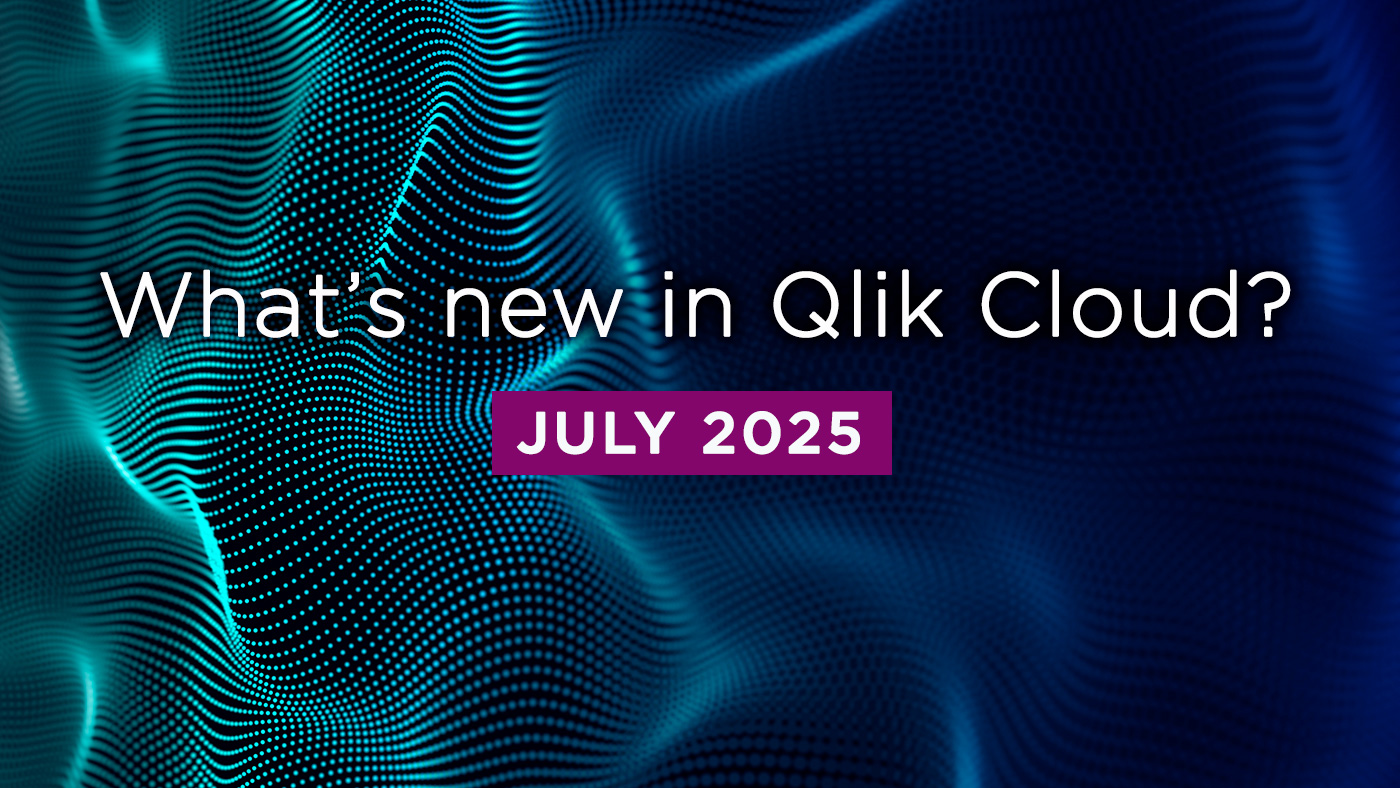
What’s New in Qlik Cloud
– July 2025 Updates –
Welcome to the next edition of the ‘What’s New in Qlik Cloud’ blog for July 2025!
Authors: Roger Gray, BI Manager & Tom Cotterill, BI Consultant, at Climber.
Data Analytics
Qlik is kicking off the second half of the year with a host of improvements designed to make your Qlik Cloud experience even better – whether you’re a report writer, building automations, fine-tuning analytics apps, managing ML workloads, or strengthening security. Here’s a detailed look at what’s fresh this month.
1. HTML Reports for Email
You can now build custom HTML reports within apps and use them directly in email report tasks – as the email body or as attachments. This gives you more flexibility in how insights are presented to your stakeholders, directly in their inbox.
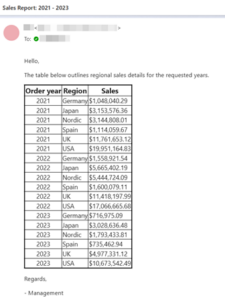
2. Improvements to PixelPerfect Template Editor
The in-app PixelPerfect template editor sees two key enhancements:
- Autosave is now on by default (saves every 30 seconds) eliminating the need to manually save the template.
- Image sizing controls allow you to better manage Qlik image scaling in both PixelPerfect and HTML reports.
3. Pivot Table Indicators
The latest pivot table now supports indicators – quickly add icons or colours based on measure thresholds. Great for at-a-glance insights.
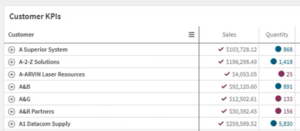
4. New Straight Table Becomes Default
The improved straight table is now the default option when adding tables to sheets. The old table hasn’t vanished just yet – it’s still available but marked as “retired” in the asset. We recommend making the switch and exploring the enhanced styling and download options.
5. New Edit Mode for Sheets
The sheet editing interface has been upgraded. It now merges the best parts of the previous standard and advanced modes, including data preview and improved filter options – making for a more intuitive edit experience.
6. Shared Automations in Qlik Automate
You can now create and manage automations directly in shared spaces, which improves collaboration and reliability across teams.
Key benefits:
- Assign and share automation tasks across your team
- Secure automations using space-level permissions
- Reduce disruptions when team members are unavailable
The new shared automation creator scope is enabled by default. Just ensure users have CanEdit rights in the shared space.
7. Automation Editor: Better UX, Smoother Workflows
Building automations just got easier. The automation editor now includes:
Collapse/Expand Blocks
You can now collapse inner blocks inside Loop and Condition blocks – a simple update that makes even complex automations easier to navigate.
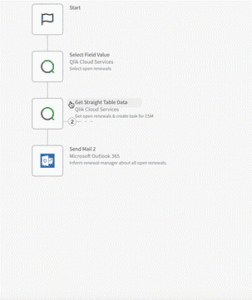
Ordered Block History
Block run history now follows the same sequence as blocks in your automation – a small tweak that goes a long way in debugging and reviewing runs more efficiently.

Relocated Settings Menu
The automation settings menu has moved to the top navigation bar for quicker access. No more digging around to update settings.
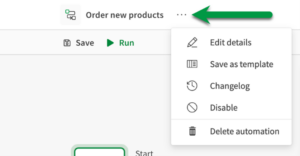
8. Reload-Time Variables & Constraints
Dynamic deployments just became easier and safer. You can now:
- Set variables at reload time using the Reloads API – no need to modify load scripts.
- Define constraints within your script to ensure variable values meet your business logic – helping prevent accidental overrides or security issues.
This update brings dynamic configuration closer to what QlikView users may remember and is a big win for multi-tenant and large-scale deployments.
9. ML Dataset Folder Support
Managing machine learning experiments just got tidier. You can now:
- Use folder paths (including dynamic ones) when naming prediction datasets.
- Organise exports from the Compare and Analyse tabs using folder structures.
10. Deprecation Notice: Developer Role and API Key Toggle
Heads-up for Admins:
- The Developer role is being deprecated and will be removed before the end of 2025. Start transitioning users to custom roles with the Manage API keys permission.
- The Enable API keys setting is also being phased out. In future, API key access will be granted solely through permissions.
11. Test On-Premise App Performance in Qlik Cloud
A useful new feature allows you to test and evaluate the performance of on-prem Qlik Sense apps within Qlik Cloud. It’s ideal for migration planning and hybrid environments – helping you benchmark and optimise before making the move.
12. Security Updates for Qlik Sense Mobile SaaS
Enhanced mobile security is here. Qlik Sense Mobile now includes new safeguards to ensure device and network compliance. If a mobile device doesn’t meet the required security standards, access may be restricted. This helps you stay compliant and secure on the go.
13. Direct Access Gateway 1.7.5
This latest update includes several key enhancements:
- Windows service account can now be set during installation.
- New logging context to help diagnose metadata preview issues (fields include requestguid, sessionid, and datasourceid).
- Async Load Data support reduces cloud-agent wait times.
- Live AGENT_LOG_OPTIONS changes without restarting the service.
- User-defined credentials for MongoDB and Google BigQuery connectors, matching their cloud-based counterparts.
Also: Windows Server 2025 is now officially supported.
Data Integration
This month’s update is all about streamlining the developer experience, enhancing trust in AI, and tightening governance across data products and pipelines. With improvements ranging from smarter SQL editing to secure SSH connectivity and AI-aware trust scoring. Qlik continues to make data integration more productive, secure, and intelligent.
1. Smarter SQL with Auto-Complete and Auto-Formatting
Writing SQL just got a whole lot smoother. Qlik Talend Cloud Pipelines now include code auto-completion and formatting for SQL transformations, helping developers move faster and make fewer mistakes. As you type, the editor suggests tables, columns, and SQL keywords, reducing context-switching, guesswork, and typos.
It’s available to all customers. Just start typing and enjoy a cleaner, quicker, neater way to write transformations. Your DBA will thank you.
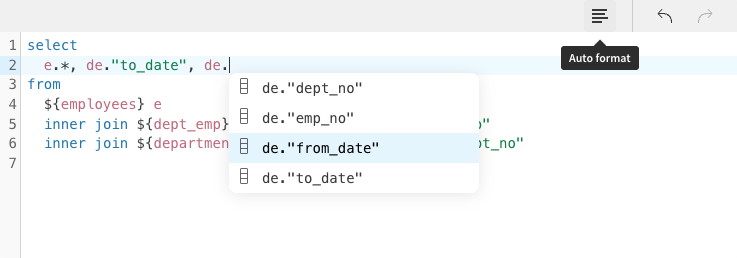
2. Catalog Filter: “Data” becomes “Datasets”
A small but helpful tweak in the Catalog filter menu. The label “Data” has been updated to “Datasets” to better reflect what’s being filtered. It’s a clearer way to navigate your assets with no change in functionality.
Find out more about browsing datasets from the ‘Catalog’ here.
3. Data Products now retain their model in Qlik Sense
When you create a Qlik Sense app from a data product, the data model defined in Qlik Talend Cloud now comes with it. There is no need to rebuild relationships manually. You’ll see the model in the Data Model Viewer in Qlik Sense, giving you a smoother transition from pipeline to visualisation.
A few things to note:
- Only the data model explicitly defined in Qlik Talend Cloud is included. Sense won’t alter anything extra.
- A previous issue where duplicate column names were automatically renamed has been fixed, so Qlik Sense’s model suggestions now work better with imported models.
- While the model is viewable in both Qlik Talend Cloud and Qlik Sense, it’s not exported as a standalone asset.
This is a nice quality-of-life improvement that helps keep your data product pipelines clean, consistent, and ready for analytics.
4. Data Product Documentation gets a big upgrade
Say goodbye tab-hopping. Qlik now provides a single, comprehensive view of data product documentation, bringing together everything from quality scores and profiling to field descriptions, lineage, and consumption details all in one place.
You can view this “Wikipedia-style” summary directly in the Data Marketplace or export it as a PDF for easy sharing and offline review. It’s a major usability boost that makes life easier for data consumers and ensures the full story behind your data is always just a click away.
Learn about generating the documentation of a data product here.
5. Use Qlik Talend Cloud Rules Directly in Talend Studio
Talend Studio users can now tap into validation rules and semantic types defined in Qlik Talend Cloud, thanks to a new integration component. This means you can apply centrally maintained rules inside Studio without redefining them. This brings better consistency, less duplication, and faster development.
What this means in practice:
- No more copy-pasting rules between platforms
- Validation logic stays consistent across your data landscape
- Centrally governed rules mean fewer errors, faster delivery
- It’s a practical step toward unified, governed data integration — without sacrificing flexibility for developers.
Read more:
6. New Import Format and Interface for Pipeline Projects
A new, streamlined user interface for importing pipeline projects is now live in Qlik Talend Cloud. Whether you’re importing a project, pulling changes, or retrieving one from version control, you’ll now see clearer controls for assigning key project settings, for instance:
- Database connections for each task
- Target systems
- Cross-project pipeline sources
- Iceberg volume and catalog selections
Behind the scenes, Qlik has also introduced a new export format. Projects now export as a ZIP file containing multiple JSON files, rather than a single JSON file. If you are worried about the old format don’t! It is still supported until January 30, 2026, giving you plenty of time to transition.
Want to convert your existing projects? Just import them and re-export using the new ZIP format.
Note: Projects in the old format can’t be imported via the API.
Read about exporting and importing data pipelines here and exporting and importing replication projects here.
7. Dedicated Menu for Data Product Management
Data product management now has a dedicated menu entry, separate from the Data Marketplace.
This small but meaningful change makes it easier for data product managers to find and manage their products and sets the stage for more improvements in future releases.
More information: Working with data products
8. Secure SSH Tunnel Access for Data Sources
You can now connect to supported data sources via an SSH tunnel, even if you’re not using a Data Movement Gateway. This provides a secure, encrypted way to access data sources behind firewalls, giving you more flexibility in hybrid or restricted network environments.
Currently supported connectors:
- MySQL
- PostgreSQL
- Microsoft SQL Server (CDC-based)
Note: This feature is not supported in Qlik Cloud Government or Qlik Cloud Government – DoD.
Read more: SSH tunnel
9. Qlik Trust Score™ Adds AI-Focused Dimensions
With AI playing an increasingly central role in analytics, Qlik Trust Score™ now includes new dimensions designed to assess the readiness of datasets for AI use. These enhancements help organisations build more reliable models, reduce bias, and ensure their data is both trustworthy and representative.
What’s new:
- Diversity: Measures the breadth and balance of your data, evaluating how well it represents the population or scenario it’s meant to reflect.
- Accuracy: Adds support for custom validation rules under a new ”Accuracy” category, with rule severity directly impacting the score.
- Timeliness: Tracks how fresh your data is by comparing actual update patterns against thresholds you define.
These additions strengthen Qlik’s data quality framework, making it easier to identify weak spots before they impact AI outcomes and putting governance front and centre in your AI pipeline.
Learn more about the Qlik Trust Score™ here.
Summary
This month Qlik Talend Cloud brings new features that help teams move faster and build smarter. Developers get ‘auto complete’ and formatting in SQL transformations, while data consumers benefit from cleaner product documentation and models that carry through into Qlik Sense apps.
Governance teams can now track trust scores for AI-readiness, enforce consistent rules in Talend Studio, and manage products more easily thanks to dedicated menus and updated import formats. With the addition of SSH tunnel access and ongoing UI refinements, the platform stays as flexible as it is powerful.
SUBSCRIBE
Want to stay up to date with the latest features that are released in Qlik Cloud?
Subscribe to our blog and get monthly updates directly to your inbox.
WANT TO KNOW MORE? CONTACT US!
Magnus Petersson-Ahrholt
BI Manager
magnus.petersson-ahrholt@climber.se
+46 70 830 27 35
Thomas Christian
Business Relationship Manager
thomas.christian@climber.se
+46 72 401 47 47
News
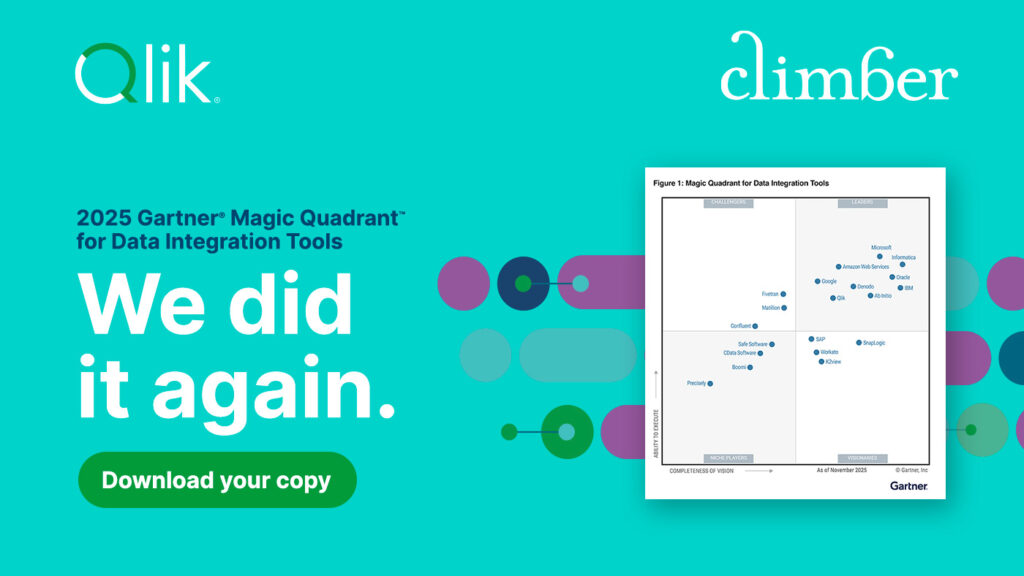
Qlik a Leader in the 2025 Gartner Magic Quadrant for Data Integration Tools
Unsure of how to evaluate the best solution for your needs? Get your free copy of the 2025 Gartner Magic Quadrant report for Data Integration for a quick overview of the landscape and see why Qlik has been named a Leader for the tenth time in a row.
>> Download the report
Climber stödjer Stadsmissionen i Stockholm och Skåne
Var åttonde barn i Sverige lever i fattigdom – därför gör vi annorlunda i jul. Vi stöttar stadsmissionen i arbetet att skapa en jul för alla.
>> Läs mer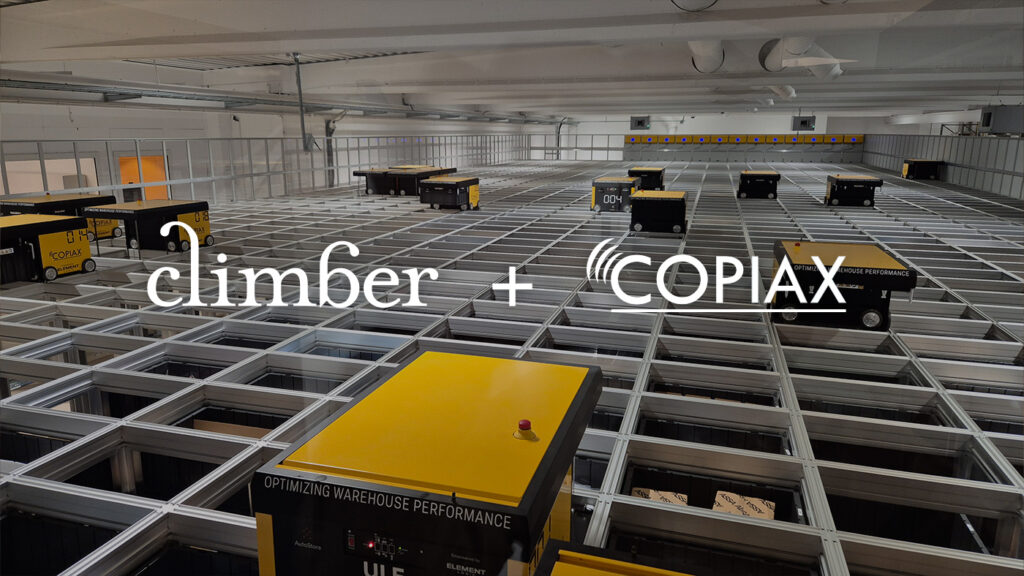
Så använder Sveriges största säkerhetsgrossist AI för att stärka kundrelationer
Sveriges största säkerhetsgrossist, Copiax, använder AI-driven analys för att identifiera kunder med vikande köpbeteende – och får insikterna levererade som poddar.
>> Läs mer om projektet här
